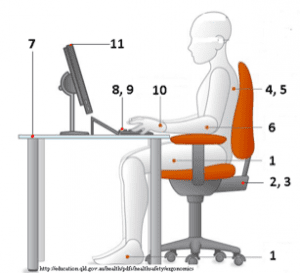Desk Ergonomics
Correct sitting posture is essential for minimizing musculoskeletal disorders or injuries such as repetitive injuries to the shoulder or elbow and neck or lower back pain. Studies have shown that improper sitting posture or prolonged sitting can lead to stiffness, decreased movements and insufficient nutrition to the spine. Decreased physical activity associated with increased sitting at workplaces has also been linked to various illnesses such as cardiovascular diseases.
Although working in the same posture or prolonged sitting may not be advised, various current guidelines recommend a sitting posture that encourage supported upright back with right angles at elbow, hips, knees and ankles. Sit-stand desks and active workstations are often considered as alternatives to improve sedentariness, but they may not have considerable effect on musculoskeletal symptoms or work performance.
Recommendations to set up your work desk and chair
Seat considerations
 Seat Height: An optimal height of the work chair should allow the feet to be able to rest flat on the floor with the thighs roughly parallel to the floor. Ensure even pressure distribution at the back of your thighs.
Seat Height: An optimal height of the work chair should allow the feet to be able to rest flat on the floor with the thighs roughly parallel to the floor. Ensure even pressure distribution at the back of your thighs.- Seat Width and Depth: Too wide or deep seat may prevent proper use of armrests and backrest. Ensure there is no pressure behind your knees from the front of the seat pan.
- Seat Tilt: A fixed tilt angle is preferred over a dynamic tilt chair. Various tilt angles- fixed to upright, forward up to 10 degrees or backward up to 5 degree are recommended as optimal. When choosing forward or backward tilt its essential to ensure a slid-resistant cushion and adequate support for your foot and trunk.
- Backrests: Adjustable backrests that would provide adequate lumbar support and buttocks clearance is recommended. If you have back pain, consider discussing with your therapist in choosing between a high or low lumbar support.
- Backrest Tilt: A backrest inclination of upright (90 degrees) to an angle of 120 degrees is advised.
- Armrests: Use of an adjustable armrest is preferable to support the arms during keyboard and mouse use. Height and length of the armrest should allow your upper arm to be vertical and forearm, parallel to the ground with the wrist in a neutral position. Avoid bending your wrist up more than 10 degrees or bending down more than 30 degrees while typing or using a mouse.
Desk considerations
An adjustable desk and seat height are ideal to allow the user to achieve both an optimal keyboard-to-forearm relationship and adequate leg clearance.
- Desk Height: An optimal work surface/desk (or keyboard tray) height should be at level with or slightly below your elbow height.
- Keyboard: Keyboard kept at a distance of more than 12 cm from the desk edge allows forearm/wrist to rest when you are not typing. This has been shown to lower the risk of hand arm symptoms and disorders. Avoid prolonged use of laptops or use a separate keyboard with docking station. Discuss with your therapist when considering alternative keyboard styles for specific impairments.
- Mouse: You must choose a mouse that is the right size for your hands and should be positioned to allow easy transition to the keyboard. Positioning the mouse closer to the centerline of the body is advised to promote more neutral wrist and shoulder position and to minimize forearm muscle activity.
- Palm/wrist Supports: They are not designed to be used while using keyboard/mouse, rather for using while taking short breaks from typing or using the mouse.
- Monitor Position: It is recommended to position the monitor below eye level and directly in front of the user to maintain a comfortable viewing angle (10 to 25 degrees). An angle of 30-35 degree is recommended for touch-screen displays. Distance to the screen should be more than 40cm with display character sizes adjusted for easy reading.
- Desk Area: (see the diagram). Consider keeping frequently used items in the usual work area (keyboard, mouse).
- Lighting: Ensure adequate lighting without any glare on the screen. Check for any glare or reflection on your screen with the display turned off.
Other Considerations:
- Regular breaks: As any prolonged posture is not ideal, regular breaks will promote improved blood circulation through your joints and muscles. Take short 30 sec breaks as needed from typing by resting your palm on your lap or desk. Keeping infrequently used items away from your desk will encourage you to stand up and move away from your workstation/seated position.
- Use of notebook over your lap has shown to increase the strain to the neck and wrist. Using a lap-desk or lap try can significantly reduce this.
- A sturdy footrest with adjustable slope and non-slip surface should be used if your feet cannot be placed flat on the floor.
- When using documents along with computer, prop up the document beside the monitor or in-between the monitor and keyboard.
- An inclined desk surface is recommended for writing and drawing.
- A scalloped desktop (desk with shallow curve cut out at the centre) or L-shaped desk can provide more forearm support, greater desktop space within an acceptable reach.
Nejin Chacko PT, BPT, MSc (Medicine and Science in Sports and Exercises).
https://applecreeksportsmedicine.com/nejin-chacko-p-t/
References
How to Make Your Computer Workstation Fit You.2009; 2017(Sep). Available from: https://www.worksafebc.com/en/resources/health-safety/books-guides/how-to-make-your-computer-workstation-fit-you.
Office Ergonomics Guideline.2013; 2017(Sep). Available from: http://education.qld.gov.au/health/pdfs/healthsafety/ergonomics-guide-2013.pdf.
Straker L, Abbott RA, Heiden M, Mathiassen SE, Toomingas A. Sit–stand desks in call centres: Associations of use and ergonomics awareness with sedentary behavior. Applied Ergonomics. 2017;44:517-22.
Shrestha N, Kukkonen-Harjula KT, Verbeek JH, Ijaz S, Hermans V, Bhaumik S. Workplace interventions for reducing sitting at work. Cochrane Database Syst Rev. 2016;3:Cd010912.
Woo EH, White P, Lai CW. Ergonomics standards and guidelines for computer workstation design and the impact on users’ health – a review. Ergonomics. 2016;59(3):464-75.

 Seat Height: An optimal height of the work chair should allow the feet to be able to rest flat on the floor with the thighs roughly parallel to the floor. Ensure even pressure distribution at the back of your thighs.
Seat Height: An optimal height of the work chair should allow the feet to be able to rest flat on the floor with the thighs roughly parallel to the floor. Ensure even pressure distribution at the back of your thighs.